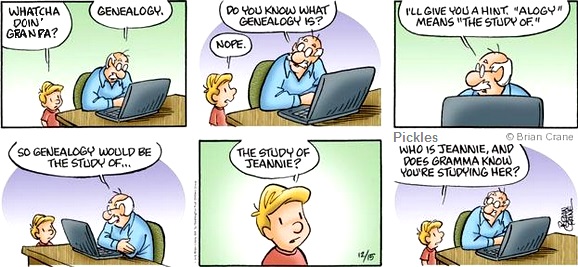|
The
|
THE BURGENLAND BUNCH NEWS - No. 313 September 30, 2020, © 2020 by The Burgenland Bunch All rights reserved. Permission to copy excerpts granted if credit is provided. Editor: Thomas Steichen (email: tj.steichen@comcast.net) BB Home Page: the-burgenland-bunch.org BB Newsletter Archives: BB Newsletter BB Facebook Page: TheBurgenlandBunchOFFICIAL Our 24th year. The Burgenland Bunch Newsletter is issued monthly online. The BB was founded in 1997 by Gerald Berghold, who died in August 2008. |
| Current Status Of The BB: * Members: 2983 * Surname Entries: 9051 * Query Board Entries: 5842 * Staff Members: 13 |
This newsletter concerns: 1) THE PRESIDENT'S CORNER 2) HISTORICAL BB NEWSLETTER ARTICLES: - PROFESSOR TRACES AUSTRIAN MUSIC IN LEHIGH VALLEY 3) ETHNIC EVENTS 4) BURGENLAND EMIGRANT OBITUARIES (courtesy of Bob Strauch) |
1) THE PRESIDENT'S CORNER (by Tom Steichen)  Still
wearing my mask when out and about... hope you are too. But I also, this month, starting growing a "Covid" filter...
just one more "activity" in these busy times! Still
wearing my mask when out and about... hope you are too. But I also, this month, starting growing a "Covid" filter...
just one more "activity" in these busy times! This month's bits and pieces (Article 1) starts out with two related bits about composer Josef Haydn, who is memorialized in the Haydn House in Eisenstadt for his musical work for the Esterházys. We follow that with some interesting, additional information about the pending "Our Americans" Landesmuseum Exhibition. Next, we share an old postcard featuring Lackenbach and then tell you about two significant changes to the BB website. We then report that Walter Dujmovits has been honored by the Burgenland Kery Foundation for his lifetime of work documenting the Burgenländer emigration. We conclude this section with our regular tidbit features: the monthly BB Facebook report, book sales and a humor item. We do not have an extended article this month, so we close with our standard sections: Historical Newsletter Articles, (no) Ethnic Events and Emigrant Obituaries. Excellent and Educational Josef Haydn Video: BB member, Nina Egert, shared a link to a 53-minute video about Austrian-born composer, Josef Haydn, who spent much of his career working for Burgenland's Esterházy family. Haydn is considered the inventor of the "string quartet" (composed of two violins, one viola and one cello). 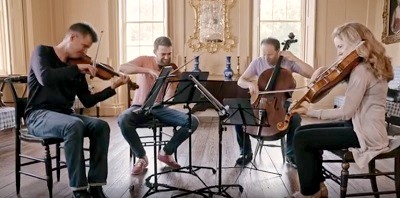 The video explores the 18th-century
origins and inspirations behind the string quartet, traveling between Austria, England and Charleston, SC, to tell the
story. The story-telling is excellent, the music is sublime, and the settings are wonderful. This is part of PBS' "Great
Performances" family of shows, being an episode in the "Now Hear This:" series entitled, "Haydn: King of
Strings.” These videos typically remain on the website for only a limited run so, if interested, watch it soon (this one
expires 10/16/20)... you won't be disappointed! You can find it here:
https://video.whyy.org/video/now-hear-this-haydn-the-king-of-strings-wcnzne/ The video explores the 18th-century
origins and inspirations behind the string quartet, traveling between Austria, England and Charleston, SC, to tell the
story. The story-telling is excellent, the music is sublime, and the settings are wonderful. This is part of PBS' "Great
Performances" family of shows, being an episode in the "Now Hear This:" series entitled, "Haydn: King of
Strings.” These videos typically remain on the website for only a limited run so, if interested, watch it soon (this one
expires 10/16/20)... you won't be disappointed! You can find it here:
https://video.whyy.org/video/now-hear-this-haydn-the-king-of-strings-wcnzne/ In an interesting coincidence, restoration of a Haydn piano has just been completed by the Burgenland government. 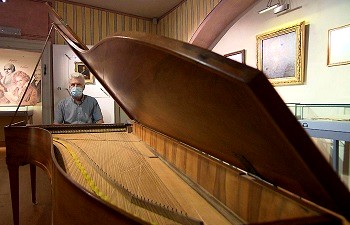 The
4-month extensive restoration process cost around 10,000 euros and has returned the historical fortepiano (grand
piano) to playable condition. It is now back on display in the Haydn House in Eisenstadt and will be played for
visitors on October 3rd, 4th and 10th. The
4-month extensive restoration process cost around 10,000 euros and has returned the historical fortepiano (grand
piano) to playable condition. It is now back on display in the Haydn House in Eisenstadt and will be played for
visitors on October 3rd, 4th and 10th.Tibor Nemeth, the director of the Joseph Haydn Conservatory, said of it: “It is a great thing that you can now play the instrument that Haydn played on and that it sounds again. That is particularly important to me, that these instruments are not just showpieces that you admire but that you can also hear the original sound of what it was like back then.” The fortepiano probably dates from 1781 and was bought by the Esterházy family. From the beginning of the last century, the piano was kept in the Franz Liszt Museum in Raiding but was returned to Eisenstadt in the 1950s. Since then, it has been at the heart of the Haydnhaus collection.
|
2) HISTORICAL BB NEWSLETTER ARTICLES Editor: This is part of our series designed to recycle interesting articles from the BB Newsletters of past years. Twenty years ago, Gerry reprinted part of an article from the Morning Call newspaper that concerned itself with the state of Burgenland music in the Lehigh Valley. I reprint it again now but add some discussion between Bob Strauch and myself, as I had asked him whether a "prediction" made in the article had come true. Sadly, he thinks it has. I'll let you read the newspaper article to see what that prediction was. Our discussion follows... THE BURGENLAND BUNCH NEWS - No. 88B September 30, 2000 PROFESSOR TRACES AUSTRIAN MUSIC IN LEHIGH VALLEY by Sonia Csencsits, The Morning Call (Following article was previously published in the December 19, 1988, 3rd Edition, page B03, of the Allentown Morning Call and is copyright by them. See web site archives for entire article.)  The influence of the American
melting pot might bring an end to musical traditions brought here from Burgenland, Austria, according to Viennese professor
Rudi Pietsch. The influence of the American
melting pot might bring an end to musical traditions brought here from Burgenland, Austria, according to Viennese professor
Rudi Pietsch.Pietsch, a folk music researcher, spent several months in the Lehigh Valley interviewing musicians and their audiences for a doctoral thesis he is doing to complete the requirements for a full professorship at the Institute for Folk Music Research of the Vienna Academy of Music, where he is an assistant professor. In his thesis, "Documentation on the Music of Former Burgenländers Who Immigrated to the United States, Especially to the Lehigh Valley," he notes there are many bands here, but they often play to older audiences. "The typical consumers of this music are really old," he says. "I think the music has 10 or 15 years more," he said, because there are a few young musicians who still play it. "Then we will see what happens." The problem, he believes, is that the young generation is not attuned to the music. In Austria, thousands of musicians play the traditional music for tourists and, more important, for themselves. "There is a kind of revival in Austria and it is very, very alive. In America, I did not see such a revival," said Pietsch, 37. It is difficult to describe this music, he said. It has melodies of two or more interchanging parts, is performed by small groups who improvise during performances and is passed on through what he describes as word of mouth. The button box accordion and violin are important to it, he says. "My job is to distinguish between German and Austrian, Polish and Czech. I have interviewed more than 120 players. There are about 20 bands in this area, and about 15 of them play the music of Burgenland." Another important part of Pietsch's research is the interviews with audiences. "It is a very important aspect to ask people who go why they go to hear the bands. Most of them are old, but there are some young also. But the young like television. They like rock music more than the traditional. There is no question about that." He began his research in the southern part of Burgenland. "I went there and spoke to people about the music," he says. "I learned that half the people who immigrated to America were musicians." He also learned about the Schanta family, with whom he stayed in Coplay. The family band has performed since 1957 under the direction of Emil Schanta Sr. Pietsch said the Schanta band plays Viennese waltz music with violins. "This is a very typical phenomenon of how they adapt music so they can play it. When the Viennese Philharmonic plays the waltz, there are more than 60 people playing. The Schanta band has five people. The conversion of the music is a natural talent of Mr. Schanta. It is his own arrangement. He is good. He is very good," Pietsch said. Another local band, The Happy Austrians, plays the Styrian Ländler. "That song is 200 years old," he said. "I went to visit bands, to hear them and to talk to them. I did not (tape) record only the best. I recorded every one. That is a very important aspect of the work: to find out how important the button box is, to know all aspects of this music," he said. He also interviewed band members, and even sat in with bands. "It was more of a joke. They asked me to play and I did." Most of the members "are amateurs. They have other jobs," he said, and added, "Most of the button box players . . . are kitchen players. They do it for fun. This is very important. To do something like this, to play the music, not to watch television, is a very important part of life. It is important to the culture." Austrians also settled in Chicago and New York, and Pietsch spent time in those areas. But, he said, "The finest area to work is this area. Northampton, Nazareth and Coplay have a lot of Burgenländers. Whitehall and Ironton, too, have Burgenländers. Pietsch plays violin, trumpet, piano and bass fiddle. His band, the "Tanzgeiger," is a traditional one. It was here for a five-week tour in 1986, and performed for President Reagan and at the Smithsonian Institution, as well as in Nazareth, in Utah, Colorado, Texas and Georgia.... - I like music that has roots, background and tradition. I also like barbershop music," he said. "I like to play with rules." (end of extract) My question to Bob: Hi Bob, 20 years ago, Gerry ran in the BB newsletter an article from the Allentown Morning Call about ethnic music in the Lehigh Valley. I'm curious about your opinion about the status of that music now, especially since the Professor quoted in the article gave the music “only 10 or 15 years more.” I've included the article for your review and comment. Bob replied: Although the main thrust of Rudi's research and topic of his dissertation was the folk music of Burgenländer immigrants in the Lehigh Valley (with special attention to the button accordion players), he really touched upon all aspects of folk culture and folk life. He did his research here between 1986 and 1991. I was present at many of the interviews and events he recorded. I read the dissertation in one sitting at his apartment in Vienna. As far as I know, I'm the only person in the Lehigh Valley to have read it. He did write some articles, do radio programs, and hold seminars on the topic which people here had access to. Years later he sent over DVD copies of some of the footage he recorded to the people he had interviewed. By then, many were already gone. In 2010, he spent 4 or 5 days here to do sort of an update and attended and recorded some events To get an idea of what really remains of the folk culture, I think one would need to pick apart and address each aspect individually. But generally, compared to what Rudi would have encountered here during his research years, what exists now is a shadow. In many ways, remnants of what there once was. But some things have survived and there are bright spots every now and then. For the most part, the pandemic has put a halt to public ethnic activities. Who knows to what extent things will bounce back. I replied back to Bob: Thanks Bob, I appreciate your comments. I should have recognized that asking in the time of the virus was not opportune for getting a definitive assessment. Further, the virus could act as a cut point, driving currently surviving bands and players into retirement. Still, Pietsch's comments were made 21 or 22 years ago, so his projected survival interval of 10-15 years for the music is long past. And he was specific about a type of Burgenländer music: "It has melodies of two or more interchanging parts, is performed by small groups who improvise during performances and is passed on through what he describes as word of mouth." So let me ask you specifically about that type of music... was it still be played in the prior five years? And, if so, did players still swap improvisations when playing it? And, finally, is it still be passed "as word of mouth" on to younger players? I'm not in the least surprised by your "what exists now is a shadow" comment, though I suspect that says more about the volume in the past as opposed to the number of bands/groups in the present (which, in the Lehigh Valley, still far exceeds what survives in other, older, once-ethnic enclaves). Down that line, I've written about St. Paul, which was an enclave before Chicago grew into one, and wherein there is now absolutely no "Burgenland" ethnic character of any kind remaining (nor has been for many years). I also think the Chicago enclave's character has now totally expired, as the BG group there died out a few years ago without even a closing gasp. Canada's enclaves still seem to be hanging in there, but they began so much later than others. I'll also comment about singing groups in general... church choirs have struggled to draw members in recent years, as general church attendance has fallen and younger singers feel disinclined to join the "white-hairs" who are the mainstays of the diminishing, surviving choirs. I suspect the virus is going to kill off many church choirs... and I suspect the same will happen with ethnic-music choirs. What have you seen with the Hianz'schor and other Lehigh ethnic choirs? Bob replied: I was indeed talking in relation to what existed several decades ago. I know we still have more of a Burgenland presence than the other enclaves. If we're talking just about the music, most of what was considered to be really "burgenländisch" is gone. It's very diluted. Things have morphed into a general "Austrian-German-Polka" genre. That's been happening for decades. The people that go to the ethnic events and dances are a mix. I can't estimate how many are Burgenländers, because I don't know everyone. But there are people from (or with roots in) many different German-speaking regions. Non-Germans as well. Before the pandemic, our heritage committee at the Coplay Bund was in the process of trying to re-organize a singing group similar to the Hianznchor. But that name was off the table. It had become too obscure. We had good ties to the singers at the clubs in Reading and Lancaster. Very nice, dedicated people, gung ho singers. We'd see other several times a year and be able to sing together. This year? Nothing. The regional folk songs which the immigrants brought along with them, especially those in dialect, are mostly gone. If you have the right first-generation immigrants (or even some of their US-born children) together, you can still do them. The Coplay Sängerbund Chorus was the last German club chorus in this area. It dissolved when director Joe Weber resigned at the beginning of 2019. |
3) ETHNIC EVENTS (none! ...blame the virus!) LEHIGH VALLEY, PA (none) NEW BRITAIN, CT (none) ST. LOUIS, MO (none) UPPER MIDWEST (none) |
4) BURGENLAND EMIGRANT OBITUARIES Marianne Dietz (née Grelics)  Marianne Dietz, age 80, of Palos Hills, Illinois, at rest September 8, 2020. Native of Unterzemming (Alsószölnök), Hungary. Beloved wife of the late Joseph Dietz; Loving mother of Reinhard (Mary) Dietz and Gary (Marianne) Dietz; Cherished grandmother of Andrea (John) von Helms and Matthias Dietz; Dear sister of the late Hermine Skaper, late Elona Gollinger and the late Joseph Grelics; Fond aunt of many nieces and nephews. Marianne was a proud member of DANK Chicago South [Ed: Deutsch Amerikanischer National Kongress] and the Jolly Burgenländers Social Club. Visitation for Marianne Dietz will be held on Sunday, September 13th from 4:00 – 8:00 p.m. at Hills Funeral Home, Ltd., 10201 S. Roberts Road, Palos Hills, IL 60465. Funeral Monday beginning 9:45 a.m. from funeral home to Sacred Heart Church, 8245 W. 111th St., Palos Hills for Mass at 10:30 a.m. Interment St. Mary Cemetery. Info: 708-598-5880 or www.hillsfh.com. |
| END OF NEWSLETTER (Even good things must end!) |
|
Burgenland Bunch Newsletter, copyright © 2020 by The Burgenland Bunch |
 News
News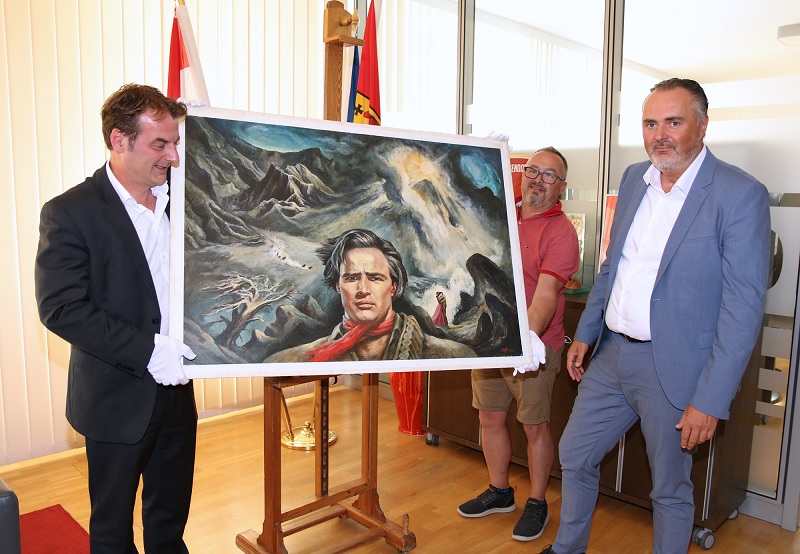 who
was born in Riedlingsdorf and who emigrated to the USA in 1923. This is the oil painting "One-Eyed Jacks" from 1961,
which was purchased from a gallery in Hollywood. “The painting was chosen because it was the template for an advertising
poster for the film of the same name with Marlon Brando - this case documents that a Burgenländer who emigrated in the 1920s
even made it 'to Hollywood'. This shows how complex the history of the Burgenland US emigration was," emphasizes
Governor Hans Peter Doskozil, who officially received the picture on Monday. The Rehberger picture is intended to be a
highlight at the State Museum's exhibition in the anniversary year, which will be devoted entirely to the fate of
Burgenländers who emigrated to the USA.
who
was born in Riedlingsdorf and who emigrated to the USA in 1923. This is the oil painting "One-Eyed Jacks" from 1961,
which was purchased from a gallery in Hollywood. “The painting was chosen because it was the template for an advertising
poster for the film of the same name with Marlon Brando - this case documents that a Burgenländer who emigrated in the 1920s
even made it 'to Hollywood'. This shows how complex the history of the Burgenland US emigration was," emphasizes
Governor Hans Peter Doskozil, who officially received the picture on Monday. The Rehberger picture is intended to be a
highlight at the State Museum's exhibition in the anniversary year, which will be devoted entirely to the fate of
Burgenländers who emigrated to the USA.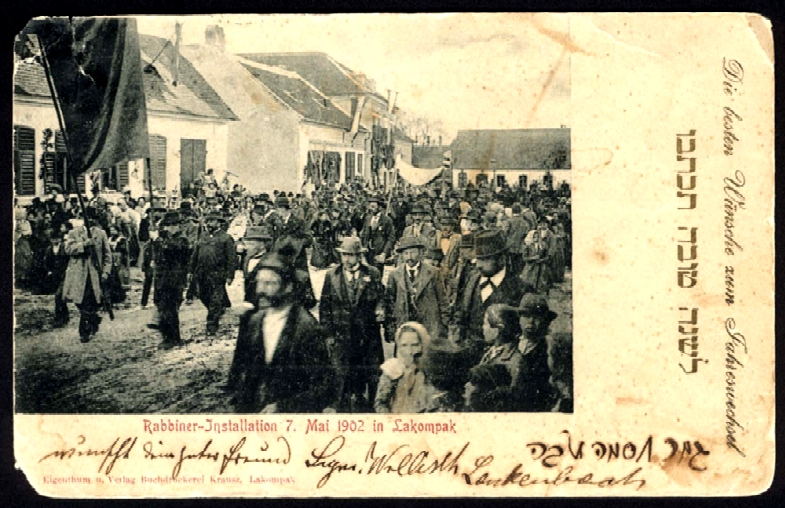
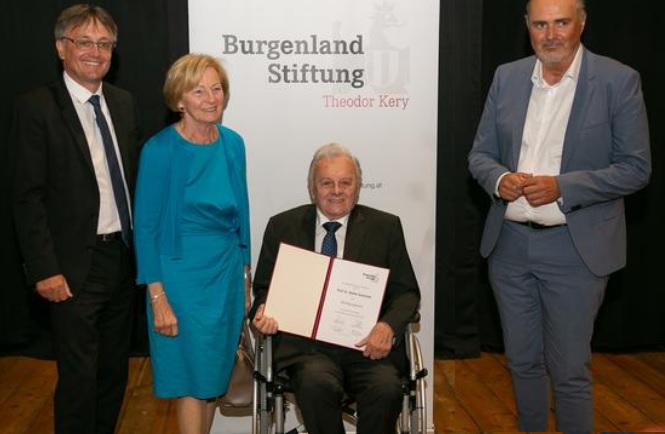 Walter
Dujmovits, was awarded one of this year's eleven prizes from the Theodor Kery Foundation for his life's work.
Dujmovits was the first historian to scientifically deal with the Burgenländer emigration to America and his book is still
regarded as a standard work that has made him known beyond national borders.
Walter
Dujmovits, was awarded one of this year's eleven prizes from the Theodor Kery Foundation for his life's work.
Dujmovits was the first historian to scientifically deal with the Burgenländer emigration to America and his book is still
regarded as a standard work that has made him known beyond national borders.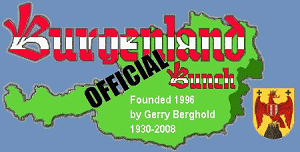 The
Facebook Bunch (from Vanessa Sandhu):
The
Facebook Bunch (from Vanessa Sandhu): Update
for book "The Burgenländer Emigration to America": Here is this month's update on purchases of the English issue of
the 3rd edition of Dr. Walter Dujmovits' book "Die Amerika-Wanderung Der Burgenländer."
Update
for book "The Burgenländer Emigration to America": Here is this month's update on purchases of the English issue of
the 3rd edition of Dr. Walter Dujmovits' book "Die Amerika-Wanderung Der Burgenländer."
